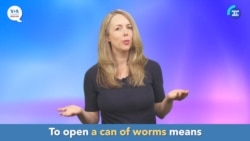Welcome to English in a minute. ຍິນດີຕ້ອນຮັບທ່ານເຂົ້າສູ່ລາຍການພາສາອັງກິດໃນ 1 ນາທີ.
This is a worm. When we fish, we can bring cans of worms to use as bait. So, does opening a can of worms just mean we’re getting ready to fish?
ນີ້ ແມ່ນຂີ້ກະເດືອນ. ເວລາພາກເຮົາຕຶກປາ, ພວກເຮົາສາມາດເອົາຂີ້ກະເດືອນກະປ໋ອງນຶ່ງ ມາໃຊ້ເພື່ອເປັນເຍື່ອລໍ້. ສະນັ້ນ, ການເປີດກະປັອງຂີ້ກະດືອນມີແຕ່ໝາຍຄວາມວ່າພວກເຮົາພ້ອມແລ້ວທີ່ຈະຕຶກປາເທົ່ານັ້ນບໍ?
Dan: Did you look over my edits to the proposal?
ແດນ: ເຈົ້າໄດ້ເບິ່ງບົດແກ້ໄຂຕໍ່ຂໍ້ສະເໜີ ຂອງຂ້ອຍລະຫວາ?
Anna: I did. You put in way too many commas, again.
ອານນາ: ຂ້ອຍເບິ່ງແລ້ວ. ເຈົ້າໃຊ້ເຄື່ອງໝາຍຈຸດຫຼາຍເກີນໄປ ອີກແລ້ວ.
Dan: No! I added commas where they are needed. It’s called the Oxford comma.
ແດນ: ບໍ່! ຂ້ອຍຕື່ມເຄື່ອງໝາຍຈຸດ ໃສ່ແຕ່ບ່ອນທີ່ມັນຈຳເປັນ. ມັນເອີ້ນວ່າ ເຄື່ອງໝາຍຈຸດຂອງ ອ໋ອກຊຟອດ.
Anna: Let’s not open a can of worms, Dan. Our deadline is tonight. Look, you put in all the commas as you want.
ອານນາ: ຢ່າມາສ້າງຄວາມຫຍຸ້ງຍາກນະ, ແດນ. ຂີດເສັ້ນຕາຍຂອງພວກເຮົາ ແມ່ນແລງມື້ນີ້ແລ້ວ. ເບິ່ງນີ້, ເຈົ້າໃສ່ເຄື່ອງໝາຍຈຸດໃສ່ທຸກບ່ອນທີ່ເຈົ້າຢາກໃສ່ເລີຍ.
To open “a can of worms” means to try to deal with or discuss a problem or situation, only to face even more problems. Anna chooses not to open a can of worms by debating comma rules with Dan.
ສຳນວນທີ່ວ່າ To open “a can of worms” ໝາຍຄວາມວ່າ ການພະຍາຍາມຈັດການ ຫຼື ເຈລະຈາ ກ່ຽວກັບບັນຫາ ຫຼື ສະຖານະການໃດນຶ່ງ, ແຕ່ຊ້ຳພັດຕ້ອງປະເຊີນກັບ ບັນຫາທີ່ເພີ້ມຫຼາຍຂຶ້ນ. ອານນາ ເລືອກທີ່ຈະບໍ່ເຮັດໃຫ້ມີບັນຫາ ຫຼື ຄວາມຫຍຸ້ງຍາກ ຫຼາຍຂຶ້ນກວ່າເກົ່າ ໂດຍການໂຕ້ຖຽງກ່ຽວກັບກົດການໃຊ້ເຄື່ອງໝາຍຈຸດ ກັບແດນ.







ຟໍຣັມສະແດງຄວາມຄິດເຫັນ